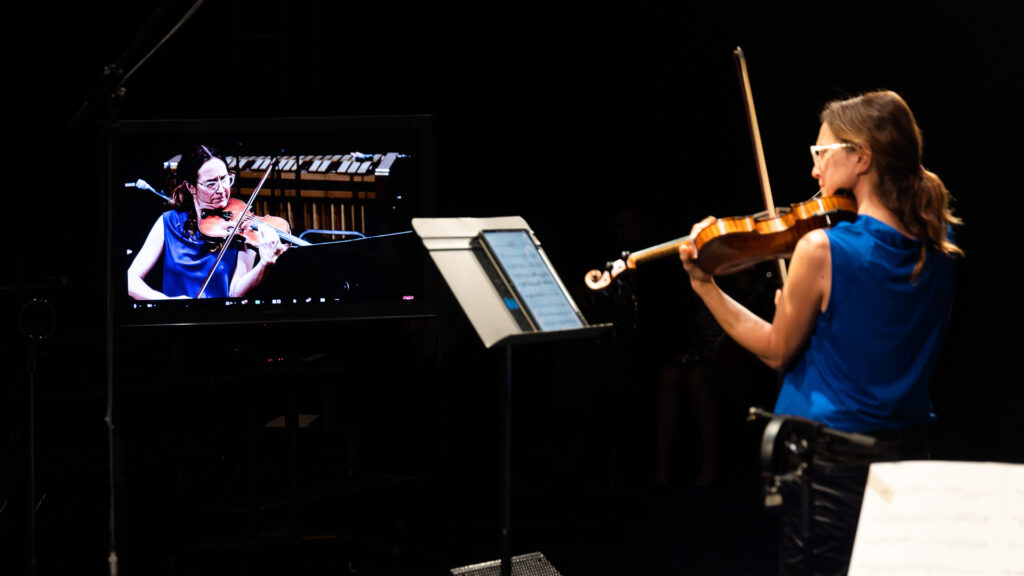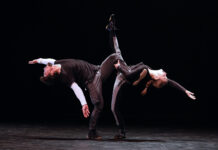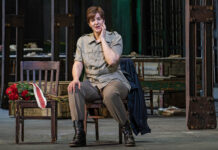Before talking about the present, a quick note about the past. Los Angeles Chamber Orchestra (LACO) has their Sound Investment Commission in which donors, usually audience members, contribute money and in return get to follow the journey a selected composer makes in creating a new work for the orchestra. Previous works given support and premieres through Sound Investment are those by Sarah Gibson, Juan Pablo Contreras, Peter S. Shin and Shelley Washington. Enter composer Marc Lowenstein.
To be fair, it is a little limiting to refer to Marc Lowenstein as just as composer. He’s also a music director (with The Industry and others) and conductor. He’s a singer and also an educator. But since we’re staying in the present, today we’ll talk about his work as a composer and also the most recent one to be a part of LACO’s Sound Investment Commission.
On Saturday, May 20th at the Alex Theatre in Glendale and Sunday, May 21st at UCLA’s Royce Hall, LACO will present the world premiere of HaZ’man HaZeh. I’ll allow Lowenstein to share details about the piece in the following excerpts from our conversation that have been edited for length and clarity. To see the full interview please go to our YouTube channel.
LACO’s Sound Investment Commission works a little bit differently than if you had gotten a commission from another performing arts organization in that the people who who donate into this program get to have a number of meetings with you, progress reports, hearing bits and pieces of a work in progress. I assume that’s very different than with any other institution.
It is very different. Although having said that, in my work in The Industry, we did do something similar in that we do workshops and we have our donors come to the workshops and we have meet and greets with them. But that’s not formalized in the way the Sound Investment program is. And it’s really formalized in a good sense: first I met and talked about my initial ideas, then I met and I had a small group of musicians play some excerpts just to check them out and to see if I could coerce one of the violinists into singing, which is a whole other issue. But I’ll tell you about that later. Then there’s one more meeting with donors right after one of the dress rehearsals. So they get to see the evolution from idea to piece and to performance.
One of the benefits of this program is the creation of modern classical works. If we don’t have contemporary works, how many Beethoven cycles can someone sit through?
Oh, my goodness, no. I’m slightly older, shall we say. So I don’t I don’t think people realize what a renaissance of modern orchestral music there is going on now today, and such a broad array of composers, different styles. 30 years ago you just couldn’t get your music performed by any orchestra. Their idea of modern music was one piece by an extremely famous person and that would anchor the season. Now it seems like almost every concert by every major orchestra has a really interesting piece. Even if it’s not successful, it’s fabulous to hear.
So I think we’re really in a tremendous renaissance of hearing a broad array of new voices of all ages and backgrounds and all musical styles. I think that’s crucial.
Of course, if we’re talking 30 years ago by one famous composer, it was either Philip Glass or John Adams.
I remember talking to my peers. All of us essentially made our own groups and our own orchestras to play the works. But there was still a barrier. It wasn’t necessarily a lack of awareness. It was sort of a blinkered mindset on the boards of all those institutions. The boards have changed and they realize that there’s all this great music out there. There’s a lot of great young composers out there.
I’m thrilled because the Sound Investment program isn’t just for young composers. I’m not exactly a young composer. I joke I’m sort of a mid-career despite my age, because of all these three different aspects that I do all the time. So I haven’t written as much as many other composers my age. But at the same time it’s refreshing that Sound Investment will have very young and untried composers with tremendous amount of promise and then somewhat older, more experienced ones. Just whoever they find interesting.
What can you tell me about HaZ’man HaZeh?
It’s about the battle, the internal struggle, between nostalgia and sort of overt futurism. So I try to reach that through a dialectic between song and dance, and then something that’s neither song nor dance.
What inspired the work and its title?
I’m not that religious, but when I am, I feel marginally drawn to the sort of the Jewish mysticism tradition and where it intersects with Buddhism. It’s not very original of me, but it’s just sort of where I sit.
My roots, in terms of what I heard as a young person, [were] romantic chamber music and classical orchestra. Then I moved into jazz. So the beginning is sort of Schumann meets Sibelius meets Charles Mingus and this sort of wild party. Then I realized that in writing all these nostalgic styles, in some ways nostalgia is a beautiful thing. In another way, nostalgia is the enemy because you can drown in nostalgia unless you make something new out of nostalgia. It can really hold you back.
Also I think if you worry too much about the future, you’re also holding yourself back. You’re not living in the present in that sense. So it’s this weird search for honesty between nostalgia and this sort of attempt to be new. I wanted to have some title that would evoke the present time, that overused word mindfulness of the present.
Then I realized there is something in the Jewish liturgy. There’s a very common prayer every time you reach a milestone, whether it’s just a happy day, a holiday, there’s a blessing. You thank God for bringing you the moment of this moment. And in Hebrew, the words are HaZ’man HaZeh, which literally means this time or the present time.
Where does a singing violinist fit into this picture?

I think one way to really live in the present is to dance. In all my music there is this binary between song and dance, and they sort of fuse together. There’s actually a song I had been working on at the same time. I didn’t think it was part of this piece. I had been setting this meditation on one of the Dalai Lama’s sayings, which is “My religion is kindness.” I’m working on the song. Can I take this block and just move it right here?
I called up the orchestra manager and I said, “Is there someone in the violin section who wouldn’t mind just getting up doing this intonation, reciting?” At our last donor salon, one of the violinists, Sarah Thornblade, stood up and she just sang. She’s breathtakingly beautiful.
How important is it for an audience to understand what a composer is trying to get across versus just listening and enjoying it?
At its best there’s no difference. I think a lot of composers would say the same thing. We hope that there’s explanation beneath it, but we certainly hope that explanation is not necessary. Having said that, a certain amount of linguistic fluency helps, or familiarity, let me put it that way.
Just as composers can get lost in the many styles that are around today, audiences, for their own good, might want to become a little fluent in things that they like. Which is just to say, if you like something, listen to it and try to figure it out. You might not. The first listen might not be as rewarding as the fourth or the fifth. Or maybe it’s not linear or something like that.
How much does working within an organization like The Industry, which has presented operas in a train station (Invisible Cities), in cars moving throughout the city (Hopscotch) and other unique locations, make you feel that we are moving in a direction where traditional expectations of how art is to be presented or consumed and genres are becoming passé?
I would rephrase it slightly with your permission. I think they’re being expanded beyond that which is passé. Let’s talk about opera, not just symphonic music for a second. I want to look at traditional opera as sort of like those Civil War reenactments. There’s a place for it and people like that. It’s a history and a culture and it’s a deep part of us. It might be a little passé, but it’s deeply important. There’s a real place for the Met and for LA Opera and Chicago Lyric and all those places. At the same time, we can’t live in the past.
Whatever the words: problematize, interrogate, question the relationship between the audience member and the work. It’s very set. If you think about going into an opera house, you know what your relationship to the work is.
Yuval Sharon, Founder and Co-Artistic Director of The Industry told me that “The inner life of the piece of music has to be made manifest on a stage.” He was talking about Invisible Cities. Does that same thought process become part of what you think about when you’re composing something for a concert hall?
I love site specific concert music that doesn’t have voices. So I think there’s always going to be a home for these really beautifully acoustically tuned halls that allow you to immerse yourself in either electronic, acoustic or some kind of sound world so that you can project yourself into the sound. I think that’s fundamentally different than what happens in opera, where it’s a story and you project yourself into the story, the narrative or the scenario. Even with music that’s programmatic, I just think it’s a fundamental difference. So when you try to problematize the symphony hall, it’s going to be different.
I think you can listen to an opera in a recording, and I think you only really get it if you’ve seen it on the stage. But that’s not true of orchestra music. You can listen to wonderful orchestra music in a recording and really get it. And really get it in a way that you just can’t get up.
Almost anyone who listens to opera, which is probably not a lot of people, have almost always seen the work before. Or have seen a video of it. It’s always marketed with visuals in a way to bring you into that story. This isn’t arguing for one form over the other. I just think we have to recognize the fundamental difference, which, of course, will have blurred lines in between it. But I think they are different. And it was very challenging to me.
I found a quote by Ray Bradbury where he said, “No sound, once made, is ever truly lost. In electric clouds, all are safely trapped, and with a touch, if we find them, we can recapture those echoes of sad, forgotten wars, long summers and sweet autumns.” How would you like your music, and this work in particular, once safely trapped, to help listeners recapture their own memories and experiences?
I read Ray Bradbury obsessively when I was 14, and he’s definitely steeped in that same sort of nostalgia that I talked about. I don’t know. I don’t know that the music has a message that it wants to give out. I hope it’s successful on its own terms. I would almost unask that question. You tell me.
I’m much more interested in how other people react to it. I know what the sounds are. I know how it sounds. I cannot predict whether it’s even partially universal in expressing what I’m trying to express or if other people get other things from it. That’s always the case.
There have been many pieces that people interpret as one thing and that the composer meant something else. So I have no good answer. I hope it’s successful. I hope people hear it. I hope it’s successful on its own terms if that means something. I’m still kind of discovering what those own terms are.
Is this work finished in your heart and in your mind?
Yes. I’m very good at saying, “Okay, let’s do the next best thing after that.” That is living in the present. The message of this piece is, in fact, to let it go and to just to do the next thing and to find your next mantra and to live in the next moment. Because that’s literally all that there is. It’s only by letting go and having a tremendous amount of throughput, I think, that you can really find the meaning in the moments.
To see the full interview with Marc Lowenstein, please go here.
Photo: Marc Lowenstein (Courtesy Marc Lowenstein and LACO)











